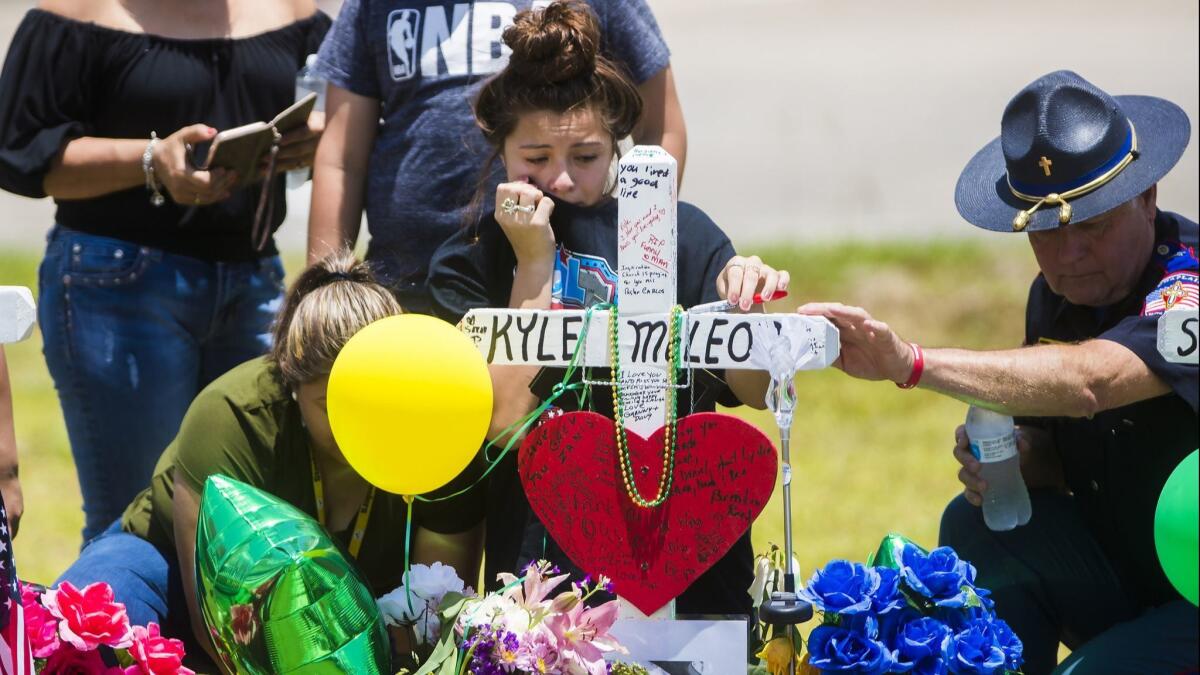Op-Ed: We will do anything to prevent school shootings — except the one thing that would work

- Share via
“I’ve always kind of felt like eventually it was going to happen here, too.”
That was what one student said at Santa Fe High School in Texas after the latest school shooting. An understandable sentiment, given how often such shootings are in the news, but mistaken statistically: With more than 55 million students in our schools, the odds of one of them becoming the victim of a mass shooting are vanishingly small.
Still, mass school shootings are common enough that the responses have become routinized, even ritualized: paramilitary police, armored vehicles, news conferences, thoughts and prayers — and more precautions.
Preparation is already the norm. Two-thirds of American school districts conduct “active shooter” drills. Most of America’s students know exactly what to do: Move to designated safe spaces, lock doors, turn off lights, silence phones, hide in closets, make the space appear empty. Then, when instructed, evacuate single-file, hands over head. Santa Fe High School had such drills, as well as armed officers and security cameras. Marjory Stoneman Douglas High School in Parkland, Fla., had drills too. “I don’t think we could have been more prepared,” one Stoneman Douglas teacher said.
Nevertheless, 17 students and teachers died in Parkland, and 10 more died in Texas this week. All that preparation wasn’t enough. So, predictably, there are calls for more precautions — for controlled entry, locked doors, bag searches — just as there were calls for more after Parkland, when Sen. Mike Rounds of South Dakota, who has an A rating from the NRA, prescribed “multiple lines of defense” at every school in the country.
The fact that guns are widely available is not some biblical plague. It’s a policy choice we make.
Every precaution, that is, except for one: Limiting access to guns. It’s the single line of defense that we as a nation are unwilling to contemplate, even though guns create the need for all those defenses.
When I was a child in Los Angeles, we held earthquake drills. But the adults organizing those drills weren’t operating a giant machine to randomly generate earthquakes. The fact that guns are widely available is not some biblical plague. It’s a policy choice we make.
But rather than confront that choice, we circle its symptoms, and many of our responses are as unnecessary as they are useless. Terrible as this latest mass shooting is, most American students will never be touched directly by one. Few of the hundreds of thousands of students who joined the March for Our Lives will ever confront an actual shooter.
Instead of treating our schools as “hardened targets,” we might consider keeping them open and unguarded. We could let our kids spend their time studying math, writing and geography rather than practicing how to hide in a closet. They might be safer this way, because the alternative presents a more insidious danger: Being slowly, subtly nudged into a state of continuous fear.
We are becoming a nation not of free people, but of first responders, sacrificing open space and minds for ever-multiplying lines of defense. And we are teaching our children to be the same.
We are conditioning them to run from danger instead of seeking its source. We are teaching them that violence is normal, that the implements of violence are a given instead of a choice. In our idolatry of the 2nd Amendment we proclaim that guns protect our freedom, but we are purchasing that freedom by chaining ourselves to an altar of fear. And so we all become victims.
We are also participants. Every time you enter a secured building, every time your company or your school organizes a shooter drill, you are being trained. Trained to walk through metal detectors instead of asking why metal detectors are needed; to supply students with transparent backpacks or ban trench coats instead of creating an environment in which a backpack isn’t a threat and a trench coat is just an eccentric fashion choice; to praise heroic teachers for saving their students instead of asking why teachers should have to die heroic deaths.
But as a participant, you can also choose to ask your human resources department, your legislator, yourself: Why are these measures necessary? Why is there one thing we have never tried? We are the ones making the earthquake.
Our children should not be slaughtered in their schools, but neither should they have to train not to get slaughtered. They should not have to learn to lock doors when their friends are screaming in the hallway, to obey the rituals so that the shooter might pass by, like the angel of death.
There’s an idea: Perhaps we should mark the doorposts with blood. Would that keep us safe? In Parkland and in Santa Fe, despite their preparations, they ended up doing that, too. And soon, in a school that almost surely won’t be your child’s, they’ll be marking the doors again.
Timothy Waters is a professor at Indiana University and associate director of its Center for Constitutional Democracy.
Follow the Opinion section on Twitter @latimesopinion or Facebook
More to Read
A cure for the common opinion
Get thought-provoking perspectives with our weekly newsletter.
You may occasionally receive promotional content from the Los Angeles Times.









